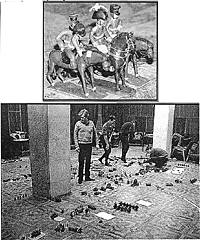
Here are some of the generals and below is the battlefield. On 5 & 6 November 2000, the French met the Allies - Prussia, Austria, and more. This photo-expose is not a battle report. That's not important (although the French lost the day). What is important is that wargaming is alive and well in Russia. However, funds are tight, space is not a problem, and time is on their side....
To the left you see the Prussian 2nd Army Corps staff. Below, the whole battle of Katzbach, 1813.
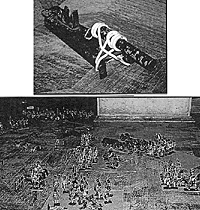
Reminiscent of HG Wells' "Little Wars", the Russian wargarning group, lead by Nikolai Scmibratov, uses a spring-loaded cannon to fire projectiles of various types, depending on who fired what. For example, an infantry volley gets two empty .22 shells per every four figures firing. A skirmisher will fire a single .22 shell. A cannon will fire a solid tin pellet that can really lay waste to the enemy with a direct hit.
You can see from this view of the French lines that the Austrian artillery has been devastating. However, you'll also note that there is no green or yellow designator for this unit, meaning that it has passed its morale test, despite the losses. You can also see that it is formed in square, probably before the attack, which helped it with its morale roll. Towards the city, an artillery unit is withdrawing because its crew was not so lucky. It failed miserably and the unit was forced to withdraw.
The 24th Infanterie de Ligne has a number of figures lying where they died. It may be difficult to see, but a couple .22 shell casings are also lying where they have caused the damage to the French. This tells me that Austrian infantry also fired on them.
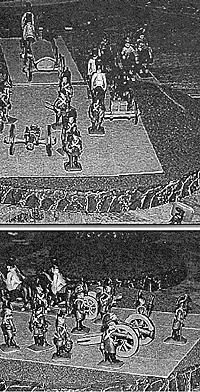
The Austrian Foot Battery is well-placed on the heights. These "heights" are War Zone GTS some of the finest terrain pieces made. Below, another view of the battery. Nikolai is meticulous in his detail - ensuring that all members of the crew are accounted for in addition to the limb
More War Zone terrain in the background and a better view of the figures. 40mm and all handmade. It really is an amazing sight!
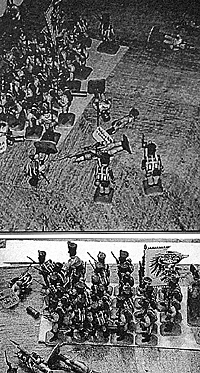
The Austrian Infantry moved forward, but ran into French skirmishers supported by artillery. The Austrians continued to move forward despite the losses (good morale). Below, you can see a custom-sized Regimental Colours flag. 40mm is obviously not a standard size for miniatures.
Note the different poses and styles. Nikolai and others personally make this figures from a modeling clay called "Plastoline". The attention to detail is amazing and the resources used in researching the colors and uniforms are incredible - Nikolai personally owns more than 100 books on the subject.
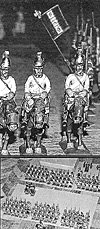
I thought this close-up would provide you a good idea of the level of detail in these figures. This group is the Reisch #6 Austrian Dragoon regiment. The flag is carried by the 24th Infantry of the Line behind them.
To the right, the French reserve waits. The French reserve can join the fight in a number of different locations , but foresight is the key to proper commitment.
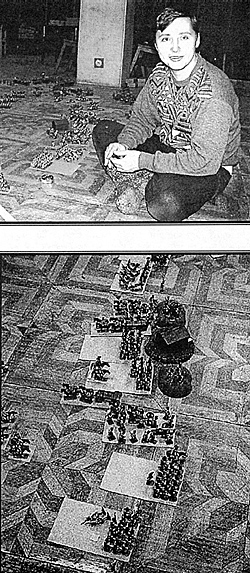
Here is the master of Napoleonic wargaming in Moscow - Nikolai Semibratov. Nik is a professional Napoleonic historian and reenactor. He knows uniforms and he knows tactics. He was the main author of the rules used by his group and these rules have evolved following numerous playtests. I would say that the only thing missing is a good random event table.
Lower Right: Here is a good overview of how the lines are formed. An artillery battery is setup between Regiments in line formation. The setup of units in the defense tells me that these are the French (who fought a completely defensive battle).
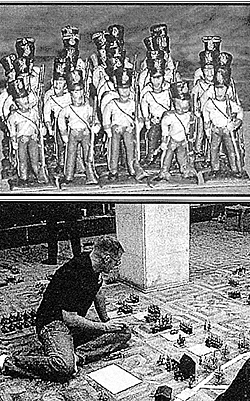
To the right is the 1st Battalion Ignaz Gyulai #60 Austrian Regiment.
What else is there to say about wargaming in Russia? Lots of space is needed because epic battles are refought. The space used here is from a small studio used for dancing & plays. The largest battle I saw had over 2000 hand made figures on the field of battle. And also I saw the Borodino reenactment where about 1000 reenactors took part at Borodino!
This is a great place for Napoleonic history and Napoleonic gaming. In addition to the 40mm figures, a couple of the folks have 1:72nd scale figures. Board games are also played here because sometimes, the dance studio/play house is not available. The good thing about board games (old S&T and Avalon Hill games being the favorites), is that they are in English. Finally, I can say that I am comfortable enough in Russian to survive a full miniature gaming session. Nikolai used to help me by translating some of the finer points, but I am on my own now...
Can I honestly say that it is not who wins or loses, but the fact that the game can be played that is most important? You haven't seen these guys argue a point on whether a cavalry attack is within range when it touches a hill or can the distance around the edge of the hill still work. They take this seriously and love the engagement, both verbally and with the miniatures. The dejected losers help pack the figures and all carry them back to their storage places in apartment closets until the next game, when the excitement is fresh and all are ready to game again. Each game ends looking for the next game. I know this article looks disjointed, but it's all part of the game.
Craig Martelle lines up on the French left flank in order to conduct defensive fire on the Austrians. As it turned out, a single volley from the artillery battery caused 30% losses in one regiment! The second volley removed the leadership of two regiments (beauty ricochet)!
Back to MWAN #110 Table of Contents
Back to MWAN List of Issues
Back to MagWeb Magazine List
© Copyright 2001 Hal Thinglum
This article appears in MagWeb (Magazine Web) on the Internet World Wide Web.
Other military history articles and gaming articles are available at http://www.magweb.com